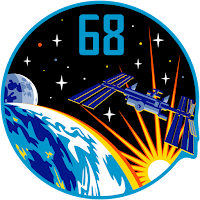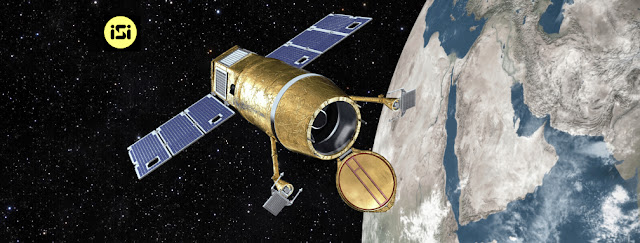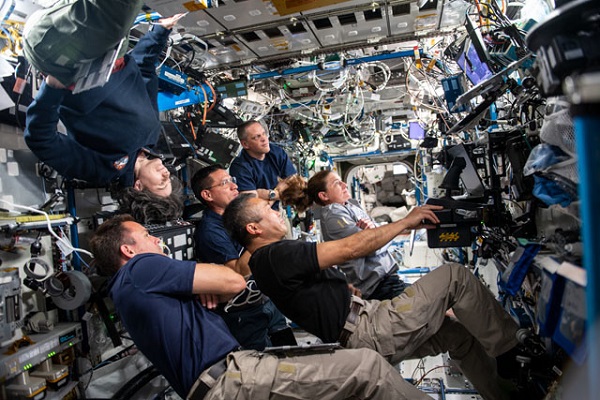ISS - International Space Station emblem.
Dec 28, 2022
The International Space Station continues its scientific journey orbiting over 200 miles above the Earth’s surface.
International Space Station (ISS). Animation Credit: ESA
Spacecraft carried crew from around the world to and from the space station, where they participated in and supported hundreds of scientific investigations and technology demonstrations this past year. From deploying CubeSats to studying fluid dynamics in space, the orbiting lab expanded its legacy of science and discovery for the benefit of humanity.
Look back at some of the best photos of breakthrough science the crew members conducted in 2022.
Understanding microgravity movement
NASA astronaut Bob Hines participates in the GRASP investigation to help researchers better understand if and how gravity acts as a reference for the control of reach-to-grasp movement. The information could provide further insight into the human body’s adaptation to the microgravity environment. Image Credit: NASA.
Converting plant waste into food
A view of Plate Habitat at -20°C prior to insertion into the Space Automated Bioproduct Laboratory (SABL) incubator aboard the International Space Station. The Protein Manufacturing project demonstrates the use of novel bioreactor technology for converting inedible plant materials and other wastes into high-protein, edible fungal biomats in microgravity. Image Credit: NASA.
Growing without soil
NASA astronauts Jessica Watkins and Bob Hines work on XROOTS, which uses the space station’s Veggie facility to test hydroponic and aeroponic techniques to grow plants rather than using traditional soil. These techniques could enable large-scale crop production for future space exploration. image Credit: NASA.
Party of six
Crew members gather in the Destiny module, the primary research laboratory for U.S. payloads, to participate in an evening conference with mission controllers on the ground to review experiment schedules and receive updates. From front to back are NASA astronaut Josh Cassada; Japan Aerospace Exploration Agency (JAXA) astronaut Koichi Wakata; ESA (European Space Agency) astronaut Samantha Cristoforetti; and NASA astronauts Frank Rubio, Nicole Mann, and Bob Hines. Image Credit: NASA.
In space for Earth
NASA astronauts (from left) Thomas Marshburn and Mark Vande Hei gaze out the station's cupola windows at Earth below. The Crew Earth Observations investigation provides researchers with key data from the perspective of the International Space Station to understand how the planet is changing over time. Image Credit: NASA.
Three CubeSats start their journey
A trio of CubeSats (TUMnanoSAT, FUTABA, and HSU-SAT1) designed for education and research programs are pictured moments after their deployment from a small satellite deployer (top right) positioned outside the Kibo Japanese Experiment Module (JEM) as the space station orbits 259 miles above the Atlantic Ocean. Image Credit: NASA.
Calls to seven continents
NASA astronaut Kjell Lindgren uses the amateur radio in the Columbus module to participate in the annual Amateur Radio Relay League (ARRL) Field Day. Field Day provides amateur radio operators the opportunity to practice operating their equipment under simulated emergency conditions. During his time on station, Lindgren made ARISS contacts with people on all seven continents, including the space station's first call to Antarctica. Image Credit. NASA.
All about the bones
Koichi Wakata of the Japan Aerospace Exploration Agency (JAXA) installs the Osteogenic Cells experiment. This experiment looks at whether bone loss in microgravity is restricted to a particular osteogenic or bone-forming cell type. This research tests the hypothesis that the underlying process results in decreased bone formation rather than increased loss of existing bone. Image Credit: NASA.
Igniting science
NASA astronaut Jessica Watkins services components that support the Solid Fuel Ignition and Extinction (SOFIE) fire safety experiment inside the International Space Station's Combustion Integrated Rack. The experiment provides hardware to allow for the study and characterization of the ignition and flammability of solid spacecraft materials in realistic atmospheric conditions. Image Credit: NASA.
Let the fluids flow
A view of a transparent FLUIDICS sphere aboard the International Space Station. The investigation covers two aspects of fluid mechanics: the analysis of liquid sloshing phenomena in tanks of spacecraft in microgravity and the wave turbulence phenomena that occurs at the surface of liquids. The investigation could support development of better fuel systems for satellites and may provide a better understanding of how the Earth’s oceans work. Image Credit: NASA.
Unlocking the cotton genome
NASA astronaut Raja Chari performs the final harvest of cotton cell cultures as part of the Plant Habitat-05 investigation (PH-05). This space agriculture study explored genetic expression in cotton cell cultures to learn more about the process of plant regeneration, potentially contributing to improved crop production on Earth. Image Credit: NASA.
Power up
NASA astronauts (left to right) Josh Cassada and Frank Rubio pictured during a spacewalk installing a roll-out solar array, or iROSA, to the International Space Station's starboard truss structure. Once all six iROSAs are installed, the station’s power generation is expected to increase to a combined total of more than 250 kW, more than a 30% increase, benefiting space station research and operations. Image Credit: NASA.
Space debris removal
A view of an Astrobee ROAM Operations Session 2 in the JEM during Expedition 66. ROAM demonstrates processes for a robotic craft to rendezvous with debris in space. Space debris includes satellites that could be repaired or taken out of orbit, but many of these objects are tumbling, making rendezvous and docking challenging. ROAM uses the space station’s Astrobee robots to observe and understand how targets tumble and uses this information to plan ways to safely reach them. Image Credit: NASA.
Expanding plant growth capabilities
NASA astronaut Kayla Barron checks out plants growing inside the Veggie plant research facility for the Veggie PONDS experiment. The investigation tested ways to grow crops in space, which could be used to support long-term crewed missions to the Moon, Mars and beyond. Image Credit: NASA.
Space archeology
NASA astronaut Thomas Marshburn poses with a ruler and color chart aboard the International Space Station. The ruler and chart are used for SQuARES, which studies how crew members use different objects and spaces on station over time. Results from this study could be used to inform the design of future crewed spacecraft. Image Credit: NASA.
Sending samples home
ESA (European Space Agency) astronaut Samantha Cristoforetti is pictured packing cargo inside the 25th SpaceX Dragon resupply ship before it undocked from the International Space Station on Aug. 19, 2022. The spacecraft carried samples and hardware from multiple investigations, allowing researchers to continue data collection and analysis on the ground. Image Credit: NASA.
A decades-long eruption
An astronaut aboard the International Space Station took a sequence of photos of Carrizozo Malpaís, showing a decades-long eruption creating this long strip of basalt in the desert of New Mexico. Crew members on the space station photograph the Earth using handheld cameras for Crew Earth Observations. These photographs record how the planet is changing over time and monitor events needing immediate disaster-level response. Astronauts have been photographing Earth from space since the early Mercury missions beginning in 1961. Image Credit: NASA.
Boiling hot

On Mar. 15, 2022, NASA astronaut Mark Vande Hei surpassed former NASA astronaut Scott Kelly’s record by spending 355 days in space. His extended mission aboard the International Space Station provides researchers an opportunity to observe effects of long-duration spaceflight on the human body. In this image, Vande Hei sets up for the Flow Boiling Condensation Experiment (FBCE) investigation, examining a model for a heat management system based on boiling processes. Image Credit: NASA.
Space construction
ESA (European Space Agency) astronaut Matthias Maurer works on the Concrete Hardening experiment, which seeks to provide a better understanding of how concrete hardens without gravity-driven convection, settling, and pressure gradients. Results could support future lunar and planetary construction techniques. Image Credit: NASA.
It’s your destiny
An interior view of the Destiny U.S. Laboratory at night under ambient light with the main lights turned off. The Destiny module supports a variety of life and physical sciences, technology demonstrations, and educational events. In 2022, hardware for the Solid Fuel Ignition and Extinction (SOFIE) facility was installed inside Destiny's Combustion Integrated Rack opening opportunities for new combustion studies. Image Credit: NASA.
Best Space Station Science Images of 2022
Related links:
GRASP: https://www.esa.int/spaceinimages/Images/2018/06/Alexander_Gerst_during_the_Grasp_Experiment
Space Automated Bioproduct Laboratory (SABL): https://www.nasa.gov/mission_pages/station/research/experiments/explorer/Facility.html?#id=1148
Protein Manufacturing: https://www.nasa.gov/mission_pages/station/research/experiments/explorer/Investigation.html?#id=2031
XROOTS: https://www.nasa.gov/mission_pages/station/research/experiments/explorer/Investigation.html?#id=8088
Veggie: https://www.nasa.gov/mission_pages/station/research/experiments/explorer/Facility.html?#id=374
Destiny module: https://www.nasa.gov/mission_pages/station/structure/elements/us-destiny-laboratory
Crew Earth Observations: https://www.nasa.gov/mission_pages/station/research/experiments/explorer/Investigation.html?#id=84
Small satellite deployer: https://www.nasa.gov/mission_pages/station/research/experiments/explorer/Facility.html?#id=1196
ARISS: https://www.nasa.gov/mission_pages/station/research/experiments/explorer/Investigation.html?#id=337
Osteogenic Cells: https://www.nasa.gov/mission_pages/station/research/experiments/explorer/Investigation.html?#id=1823
Solid Fuel Ignition and Extinction (SOFIE): https://www.nasa.gov/mission_pages/station/research/experiments/explorer/Facility.html?#id=2060
FLUIDICS: https://www.nasa.gov/mission_pages/station/research/experiments/explorer/Investigation.html?#id=2043
Plant Habitat-05 investigation (PH-05): https://www.nasa.gov/mission_pages/station/research/experiments/explorer/Investigation.html?#id=8341
Astrobee ROAM: https://www.nasa.gov/mission_pages/station/research/experiments/explorer/Investigation.html?#id=8324
Veggie PONDS: https://www.nasa.gov/mission_pages/station/research/experiments/explorer/Investigation.html?#id=7581
SQuARES: https://www.nasa.gov/mission_pages/station/research/experiments/explorer/Investigation.html?#id=8684
Flow Boiling Condensation Experiment (FBCE): https://www.nasa.gov/mission_pages/station/research/experiments/explorer/Investigation.html?#id=2064
Concrete Hardening: https://www.nasa.gov/mission_pages/station/research/experiments/explorer/Investigation.html?#id=8538
Destiny U.S. Laboratory: https://www.nasa.gov/mission_pages/station/structure/elements/us-destiny-laboratory
Space Station Research and Technology: https://www.nasa.gov/mission_pages/station/research/overview.html
International Space Station (ISS): https://www.nasa.gov/mission_pages/station/main/index.html
Animation (mentioned), Images (mentioned), Video, Text, Credits: NASA/Ana Guzman/JSC/International Space Station Program Research Office/Christine Giraldo.
Best regards, Orbiter.ch
























































